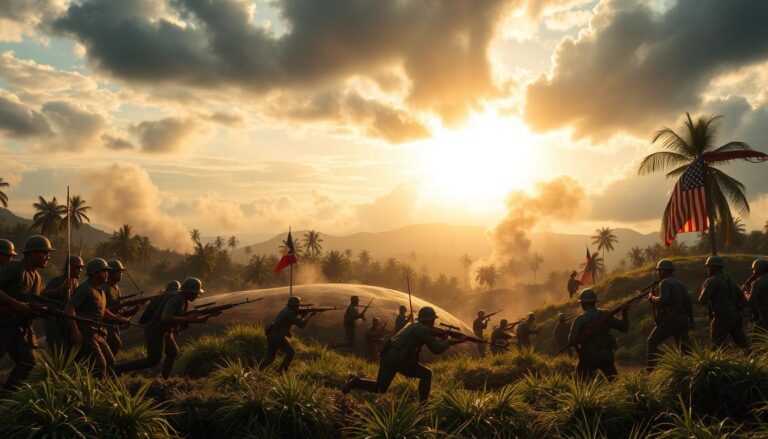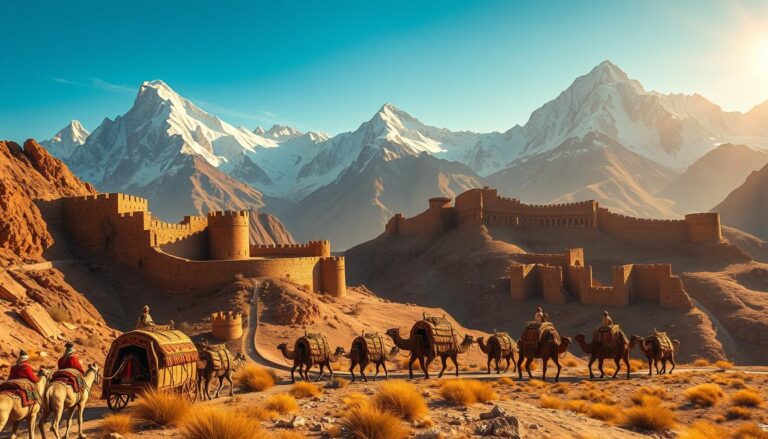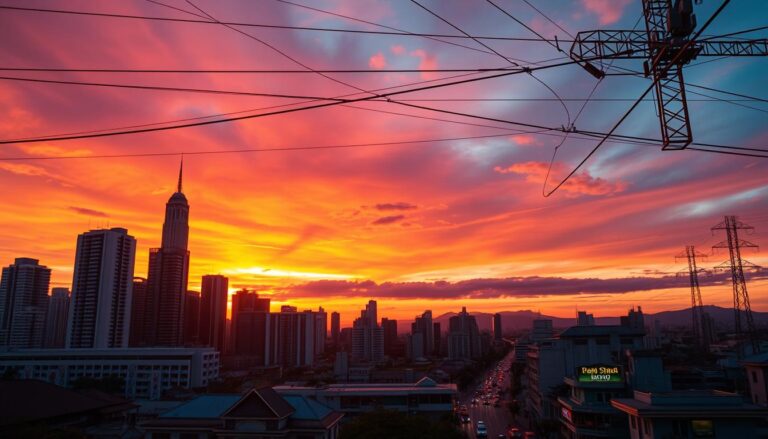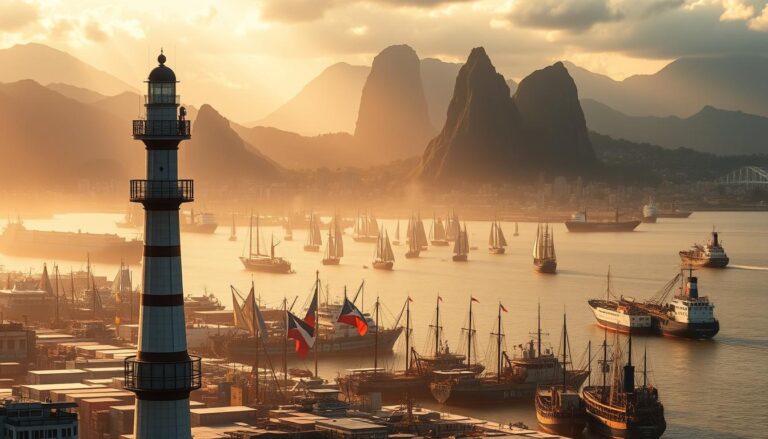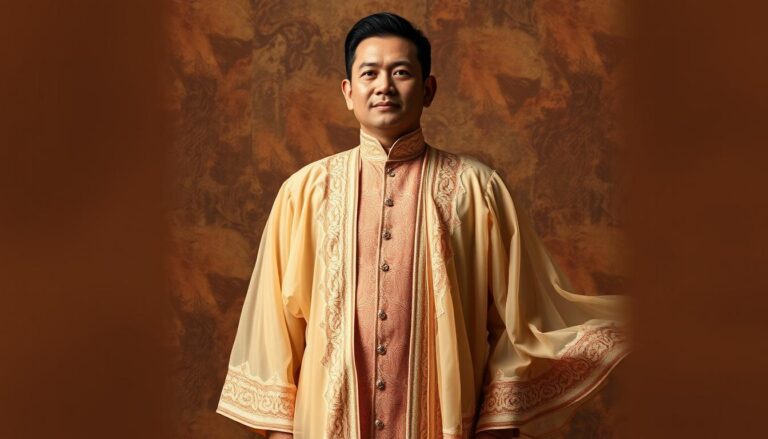Cultural History of the Philippines: A Melting Pot of Traditions
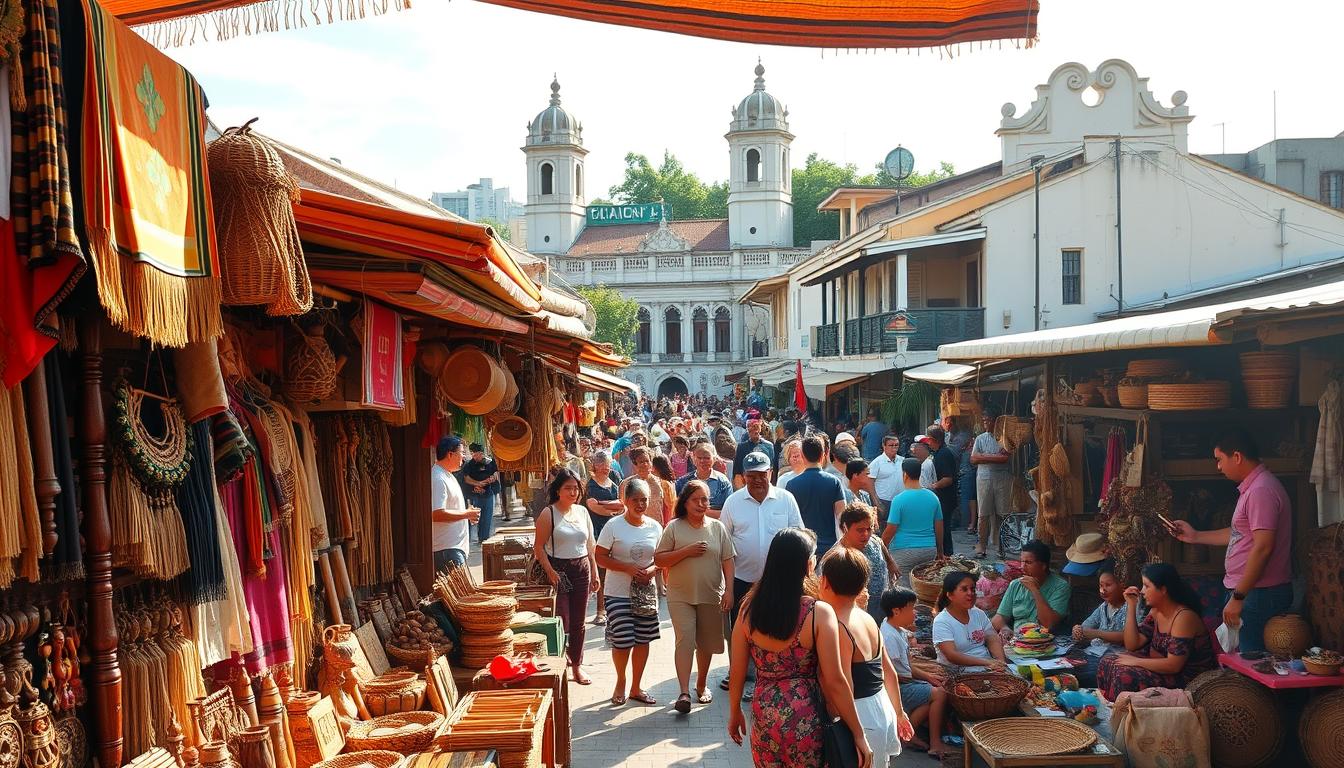
The Philippines is a vibrant mix of cultures. This country is a blend of traditions that have shaped its unique heritage. From ancient practices to colonial influences, it has become a cultural melting pot.
The Philippines has many UNESCO World Heritage sites. These include the ancient Banaue Rice Terraces and the San Agustin Church in Manila. These sites show the country’s cultural legacy. In Manila, Intramuros contrasts with modern areas like Bonifacio Global City, showing the nation’s balance between tradition and progress.
“Bayanihan” is at the heart of Filipino culture. It’s a spirit of community and collaboration. This idea of mutual support is key to the Filipino way of life.
The Philippines is known as the “Fiesta Islands.” It has many colorful festivals and celebrations all year. These events highlight the country’s rich cultural tapestry.
The cultural history of the Philippines keeps evolving. It blends ancient traditions with modern influences. This mix keeps Filipino heritage alive and relevant in today’s world.
Origins of Philippine Culture
The roots of Philippine culture go back thousands of years. They were shaped by migration and diverse influences. Cultural anthropology shows a rich tapestry of traditions that form the foundation of modern Filipino society.
Early Settlements and Austronesian Migration
The first people in the Philippines, called Negritos, arrived about 25,000 years ago. Then, Austronesian migrants from Indonesia and Indo-China came. They brought bronze and copper technology.
These early settlers built famous rice terraces. This shows their skill in agriculture.

Influence of Indigenous Groups
Indigenous traditions are key in Philippine culture. The archipelago was once home to competing tribes. Each tribe had its own rulers and customs.
These groups introduced unique customs, beliefs, and practices. They continue to shape Filipino identity today.
| Period | Cultural Influence | Impact |
|---|---|---|
| Pre-colonial | Indigenous beliefs | Animism, tribal customs |
| Spanish era | Catholicism | Religious practices, education |
| American period | English language | Education system, governance |
The National Museum in Manila has a vast ethnographic collection. It preserves the country’s cultural heritage. This mix of indigenous traditions and foreign influences makes the Philippines interesting for cultural anthropology studies.
The Spanish Colonization
The Spanish colonization of the Philippines was a major turning point in the country’s history. It started in 1565 when Miguel López de Legazpi arrived. He made Manila the capital, beginning a long period of cultural exchange.
The Arrival of Ferdinand Magellan
Ferdinand Magellan, a Portuguese explorer, landed on Cebu in 1521. This event marked the beginning of Spain’s influence in the Philippines. By 1571, Manila was founded, becoming a key center for trade with Mexico and China.
Cultural Impact of Spanish Rule
Spanish rule greatly influenced Philippine culture. The encomienda system introduced new land ownership and social structures. Spanish became the language of government and education, affecting Filipino dialects.
Architecture, art, and food also saw changes from Spanish traditions. These traditions mixed with local practices, creating a unique culture.

The Role of Religion
Catholicism became central in Philippine society under Spanish rule. Friars worked hard to convert locals, setting up missions, schools, and hospitals. The University of Santo Tomas, founded in 1611, shows the impact of this religious and educational effort.
Today, the Philippines is one of the world’s most Catholic countries. Religion is deeply part of its culture.
| Aspect | Spanish Influence | Impact on Philippine Culture |
|---|---|---|
| Language | Introduction of Spanish | Loan words in Filipino dialects |
| Religion | Catholicism | Dominant faith, religious festivals |
| Education | Spanish-style schools | Establishment of universities |
| Architecture | Spanish colonial style | Churches, government buildings |
The American Era and Its Influence
The American era was a key time in the Philippines’ history. After the Spanish-American War, the U.S. took over by July 1901. This brought big changes in how the country was run, educated, and built.

Educational Reforms
During American rule, a new education system was introduced. English became the main language taught. By 1927, almost all teachers in public schools were Filipino.
By the 1930s, literacy rates had doubled. Almost half the population could read and write.
Introduction of Democracy
The U.S. brought democracy to the Philippines. In 1907, the first elected legislative body in Southeast Asia was set up. The Jones Act of 1916 gave voting rights to all literate males.
Changes in Infrastructure
American rule also improved the country’s infrastructure. Railways and roads were built to connect the islands better. This helped trade and communication grow.
The American era had a lasting impact on the Philippines. It brought new values, ways of governing, and education. This period of cultural exchange helped shape the modern Filipino identity.
Pre-Colonial Traditions
The Pre-Colonial Philippines was a land of rich and diverse cultures. These Indigenous Traditions still shape modern Filipino society today. Cultural anthropology shows us a sophisticated civilization that thrived before foreign influences.
Indigenous Beliefs and Practices
Early Filipinos had complex belief systems and social structures. Communities called barangays were led by datus, who were both political and spiritual leaders. They made laws to help society and protect nature, mixing politics with spirituality.
They were skilled in agriculture, using swidden farming. They grew rice, millet, bananas, and root crops like taro and yam. The Ifugao rice terraces show their advanced farming skills.
“The pageantry of religions, including provincial fiestas, has roots in pre-colonial traditions, blending indigenous practices with later influences.”
Arts and Crafts of Early Filipinos
Pre-Colonial Philippines was full of artistic innovations. The Banton Cloth, the oldest warp ikat textile in Southeast Asia, shows their advanced weaving. Pottery and jewelry, like gold dagger handles, highlight their craftsmanship.

The Baybayin writing system was developed during this time. It led to widespread literacy among men and women. Spanish chroniclers noted this advanced education upon their arrival.
| Pre-Colonial Achievement | Description |
|---|---|
| Maritime Skills | Advanced navigation, construction of large ships like karakoa |
| Mining | Gold extraction at Aringay-Tonglo-Balatok trail and Paracale mines |
| Martial Arts | Use of traditional weapons: balaraw, kris, and kampilan |
| Trade Networks | Connections with China, India, and Southeast Asia |
The Role of Filipino Language
The Filipino language is key to Philippine culture. It shapes the national identity and shows the country’s rich history. Studies in cultural anthropology highlight its deep impact on Filipino society. It brings together diverse communities across the archipelago.
Linguistic Diversity
The Philippines has a rich linguistic diversity, with over 170 languages spoken. This comes from centuries of cultural exchanges and settlements. Eight major dialects are widely used in different regions:
- Bikol
- Cebuano
- Hiligaynon (Ilonggo)
- Ilocano
- Kapampangan
- Pangasinan
- Tagalog
- Waray
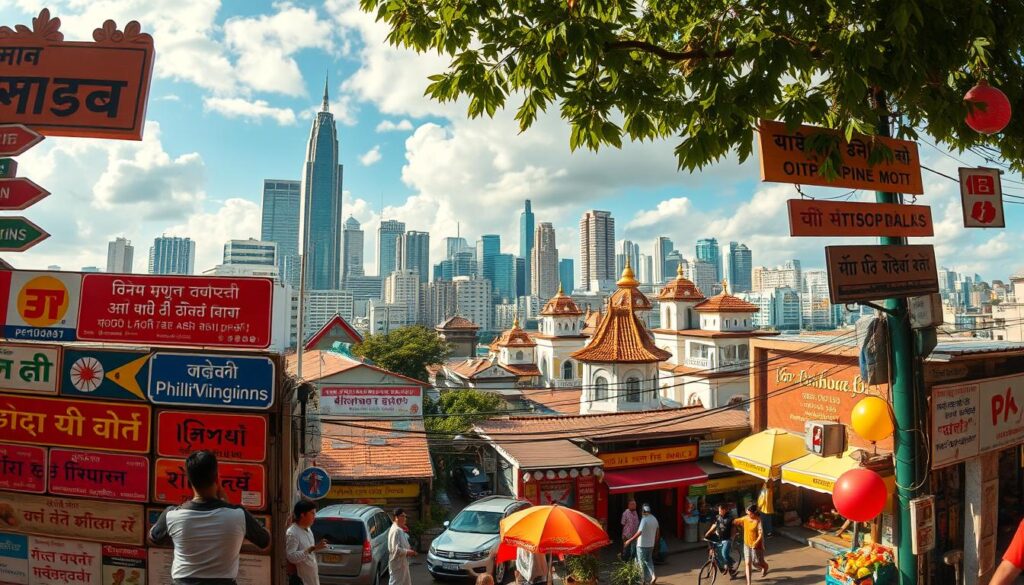
The Evolution of Filipino Dialects
Filipino, the national language, came from Tagalog and was adopted in 1987. It has words from Spanish, English, and local languages, showing the country’s past. Today, 82% of people speak Filipino, using it in media, government, and cities.
“Taglish,” a mix of Tagalog and English, shows the language’s flexibility in today’s world. This evolution keeps shaping Philippine culture. It strengthens national identity while celebrating the country’s diverse heritage.
Festivals and Celebrations
The Philippines is known for its lively festival culture. It shows off the country’s rich heritage and history. With over 42,000 festivals every year, it’s called the “Capital of the World’s Festivities.”
These colorful events highlight the nation’s varied traditions. They also help bring people from different cultures together.
Major Filipino Festivals
Filipino festivals, or “fiestas,” cover many themes and areas. The Sinulog Festival in Cebu City celebrates Santo Niño with big parades. Baguio City’s Panagbenga Festival honors nature with flower floats.
Davao City’s Kadayawan Festival shows off the area’s crops through lively dances.
| Festival | Location | Date | Highlights |
|---|---|---|---|
| Ati-Atihan | Kalibo, Aklan | January 15 | Drum beats, chants, vibrant costumes |
| Moriones | Marinduque | April 2-8 | Reenactments, dramatic performances |
| Masskara | Bacolod City | October 22 | Masked parades, street parties |
Cultural Significance of Festivals
Festivals are key in keeping Filipino heritage alive. Many started during the Spanish rule, mixing Christian and native customs. The Pahiyas Festival in Quezon Province, for example, decorates homes with harvests to thank for the food.
These events are a big part of the Philippines’ history. They draw tourists and bring communities closer. They give a peek into the country’s traditions, like the Pintados Festival in Tacloban and the Higantes Festival in Angono.
Traditional Filipino Cuisine
Filipino cuisine is a rich mix of cultures. It shows the history of the Philippines through food. This history includes influences from Chinese traders, Spanish colonizers, and American occupation.
Influences on Filipino Food
The story of Filipino food is interesting. Chinese traders brought rice, soy sauce, and lumpia. Spanish colonizers introduced tomatoes and cattle-raising. The American era brought canned meats and modern appliances.
Signature Dishes and Culinary Practices
Filipino cuisine has many famous dishes. Adobo, a meat dish in vinegar and soy sauce, gets better with time. Lechón, a whole roasted pig, is a big hit at celebrations. Sinigang, a sour soup, uses native ingredients like kalamansi.
Traditional cooking methods are key in Philippine culture. Eating with hands, or kamayan, connects people to their food and heritage. Using local ingredients like ube and pili nuts shows the importance of local produce.
Regional specialties make Filipino cuisine rich. Bicol Express from Bicol and balut from the Visayas are examples. These dishes show the variety of flavors across the Philippines. Each region adds its own taste to the national cuisine.
Literature and Storytelling
The Philippines has a rich literary history that shows its diverse heritage. From ancient stories to modern books, Filipino tales have kept traditions alive. They have also shaped the nation’s identity.
Epics and Folktales
Before the Spanish came, stories were mostly told out loud. The “Lam-ang” and “Hinilawod” epics are examples of this. These stories passed down cultural values and history.
Lola Basyang, created by Severino Reyes, is a key figure in Filipino stories. Her “mga kwento” teach morals and cultural values. This tradition has helped keep Filipino identity strong.
Impact of Spanish Literature
The Spanish brought new types of stories to the Philippines. Works like the pasyon and “Florante at Laura” by Francisco Balagtas were introduced. This mix of old and new created a unique Filipino literature.
The Laguna Copperplate Inscription marked a big change from oral to written stories. It helped keep epics like “Biag ni Lam-ang” alive. This ensured their stories stayed important in culture.
Today, Philippine literature is still growing, with stories in many languages. Authors tackle themes like identity, justice, and heritage. This shows the lasting impact of storytelling in Filipino culture.
Music and Dance
The Philippines is known for its rich music and dance. These art forms show off the country’s cultural identity. They mix different cultures but keep their own special charm.
Traditional Instruments and Their Roles
Filipino musical instruments are key in cultural studies. The kulintang, a set of small gongs, is important in Mindanao and Sulu celebrations. The gangsa, flat gongs from the Cordilleras, are used in rituals and festivals.
The Rondalla, a string orchestra brought by the Spanish, adds a beautiful sound to Filipino music. It features instruments like the banduria and guitara.
Popular Folk Dances
Folk dances in the Philippines show the country’s rich culture. The Banga, from the Kalinga tribe, is about balancing pots on the head. The Bendayan from Benguet celebrates hunters.
The Manmanok, from the Bago tribe, mimics rooster and hen movements. It shows the bond between dance and nature.
Other dances worth mentioning are:
- Lumagen/Tachok: A Kalinga dance for big events like weddings
- Turayen: From the Gaddang tribe, it imitates bird flight
- Binatbatan: An occupational dance showing cotton pod beating
- Dugso: A ceremonial dance from Bukidnon to entertain deities
These dances are kept alive by groups like the Bayanihan Philippine National Folk-Dance Company. They continue to amaze audiences and keep Filipino traditions alive.
Influence of Religion on Culture
Religion is key in Philippine culture, influencing values, traditions, and social structures. The mix of different faiths has made a unique cultural scene. This offers deep insights for those studying culture.
The Catholic Faith
Catholicism is the main religion in the Philippines, with 82.9% of people identifying as Catholic. This shows how deeply Catholic traditions have shaped Filipino culture. The fiesta tradition, a mix of Catholic and local customs, shows the importance of religious celebrations.
The Catholic Church’s influence goes beyond spiritual practices. It has shaped the country’s education, healthcare, and social services. The idea of “pamilyarism” and community values are tied to Catholic teachings.
Other Religious Practices
While Catholicism is the main religion, the Philippines has a diverse religious scene. Islam, practiced by 5-6% of the population, mainly in southern regions like Mindanao, has mixed with local traditions. This shows how different cultures can blend.
Indigenous religions, like Anitism or Bathalism, still influence Filipino culture. These pre-Hispanic beliefs included a pantheon of gods and spirits, with Bathala as the top deity. Today, these beliefs mix with Catholic traditions, creating unique practices.
| Religion | Percentage | Cultural Impact |
|---|---|---|
| Catholicism | 82.9% | Fiestas, education, social norms |
| Islam | 5-6% | Southern traditions, dietary practices |
| Indigenous Beliefs | 2% | Syncretic practices, folklore |
| Protestant | 6% | Education, social services |
This diversity in religion makes Philippine culture rich and unique. It creates a space for cross-cultural exchange and adaptation. The mix of different religious elements continues to shape Filipino identity and social structures.
Arts and Crafts in Philippine Culture
The Cultural History of the Philippines is filled with artistic traditions. These traditions show the diverse Filipino Heritage. From ancient crafts to modern art, Filipino creativity has grown while keeping strong ties to Indigenous Traditions.
Traditional Art Forms
Filipino artisans are skilled in many traditional crafts. Weaving is a key art for indigenous groups, showing their skill and cultural identity. The T’boli people make the stunning “t’nalak” fabric, and the Ilocanos are famous for their “abel Iloco” textiles.
These crafts are not just useful but also tell stories of Filipino culture and history.
Contemporary Filipino Artists
Modern Filipino art is built on this rich heritage. Famous painters like Juan Luna and Fernando Amorsolo have made a big impact. Luna’s “Spoliarium” shows the drama of history, and Amorsolo’s portraits celebrate the beauty of everyday Filipino life.
Today’s artists draw inspiration from their cultural roots and tackle modern themes. Digital platforms have changed how Filipino artisans share their work. Instagram, Facebook, and online marketplaces let them show their creations to people all over the world. They can share the stories behind their crafts and connect with customers directly.
| Platform | Benefits for Filipino Artists |
|---|---|
| Visual storytelling, global reach | |
| Community building, direct sales | |
| Online Marketplaces | Wide audience, easy transactions |
These digital tools help keep and grow Filipino arts and crafts. They make sure the rich tapestry of Philippine culture thrives and changes in the modern world.
Modern Influences on Filipino Culture
Philippine culture is changing in the 21st century. It’s influenced by globalization and cross-cultural exchange. The spirit of “Mabuhay” and traditional hospitality now mix with modern trends. This shows a dynamic national identity.
Globalization and Its Effects
Globalization has changed Filipino society. It blends old values with new practices. Even as Filipinos use global communication, they still show respect to elders with “po” and “opo”.
This mix is seen in many parts of daily life:
- Extended Christmas celebrations combining traditional and modern festivities
- Adaptation of communal dining customs in family-style meals
- “Bahala Na” philosophy reflecting resilience in the face of uncertainty
The Rise of K-Pop and Other Trends
Filipino culture is now open to international influences, mainly from Asia. K-pop has become very popular, changing fashion, music, and entertainment. This openness also affects architecture and urban planning:
- Blend of traditional Bahay Kubo design with modern materials
- Influence of Spanish Earthquake Baroque and American Art Deco styles
- Proposals for new constructions to incorporate local architectural elements
The University of Santo Tomas Main Building in Manila is a great example. It shows Renaissance Revival architecture while keeping cultural heritage. As Philippine culture evolves, it balances tradition and modernity. This enriches its unique national identity.
Cultural Preservation Efforts
The Philippines’ cultural history is a rich mix of traditions. It’s important to keep this heritage alive for our national identity. Efforts from both the government and communities work together to protect this heritage. They aim to keep our diverse cultural practices alive for the next generations.
Role of Government in Preservation
The National Historical Commission of the Philippines (NHCP) is key in preserving our heritage. It restores historical sites and manages important structures. The NHCP also enforces laws like the National Historic Act.
It collaborates with institutions like the National Museum of the Philippines and the National Commission for Culture and the Arts. Together, they ensure our cultural heritage is well-preserved.
Importance of Cultural Heritage
Keeping our cultural heritage alive is crucial for our national identity. Festivals like Sinulog, Ati-Atihan, and Panagbenga celebrate our traditions. They show our cultural richness.
Preserving traditional clothing, games, and music is also important. Legal acts like the Indigenous Peoples’ Rights Act of 1997 help too. They recognize the rights of indigenous communities over their ancestral lands.

